With thinly sliced beef and tender onions simmered in a savory-sweet sauce and spooned over steamed rice, Gyudon (Japanese Beef Rice Bowl) is synonymous with comfort. It’s is a simple, satisfying meal that’s ready in 20 minutes!
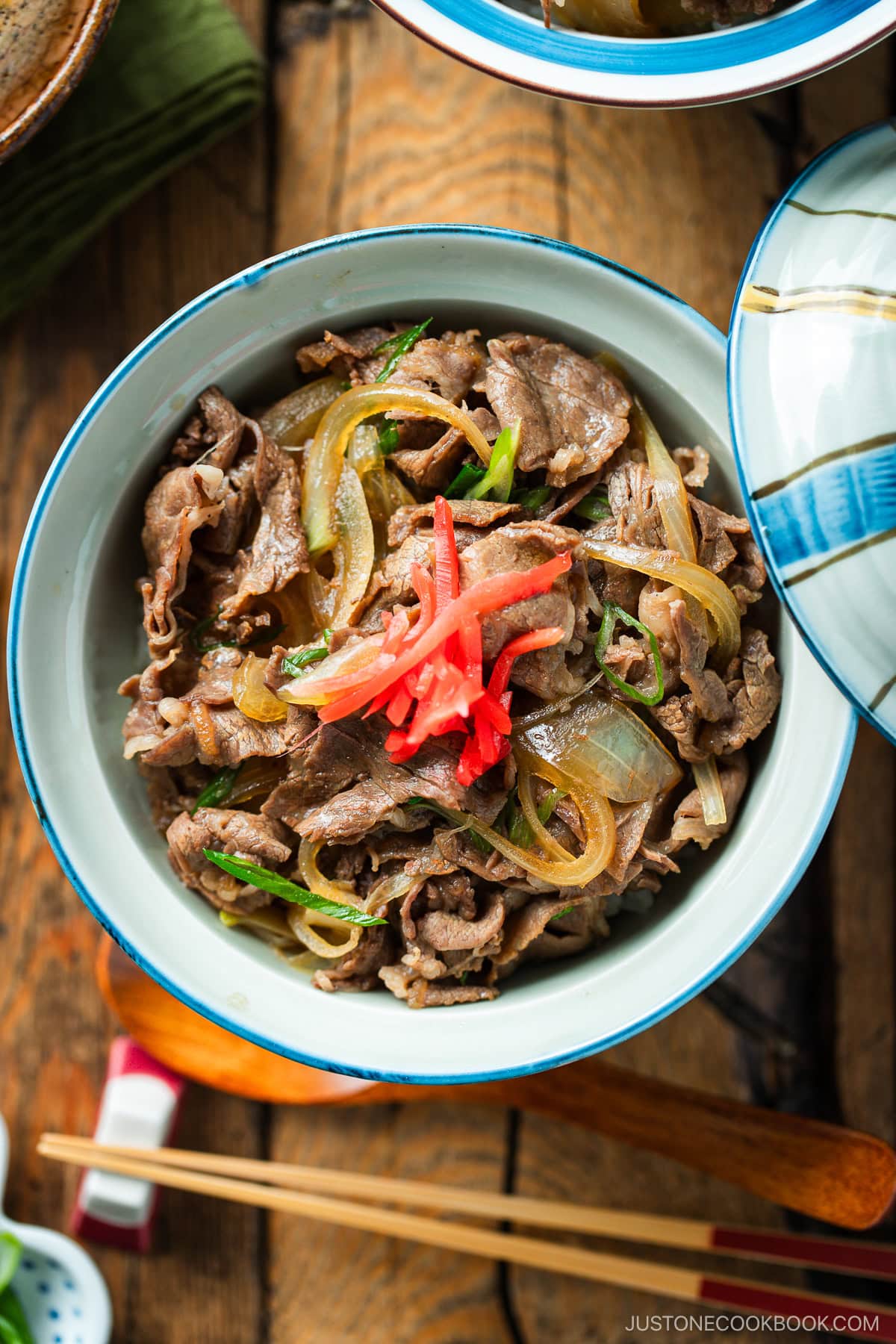
Gyudon (牛丼) is one of the classic comfort foods in Japanese cuisine that’s also become popular overseas (think Yoshinoya). It’s a quick, hearty Japanese beef rice bowl that’s extremely simple to put together—a nutritious and budget-friendly meal that’s always satisfying. While every household in Japan makes gyudon a little differently, I’ll show you my favorite version of this weeknight favorite that I make at home!
If you love Japanese rice bowls, try my Oyakodon, Unadon, and Katsudon recipes next!
What is Gyudon?
The gyudon that we love today originated in the later part of the 19th century with the arrival of Western culture. That’s when a popular beef hot pot dish called gyunabe (牛鍋) was first served in Yokohama in 1862. When people began pouring the gyunabe broth over their rice, the dish was coined gyumeshi (牛飯). In the late 1800s, it was eventually renamed gyudon, with gyu (牛) for beef and don (丼) referring to the donburi rice bowl.
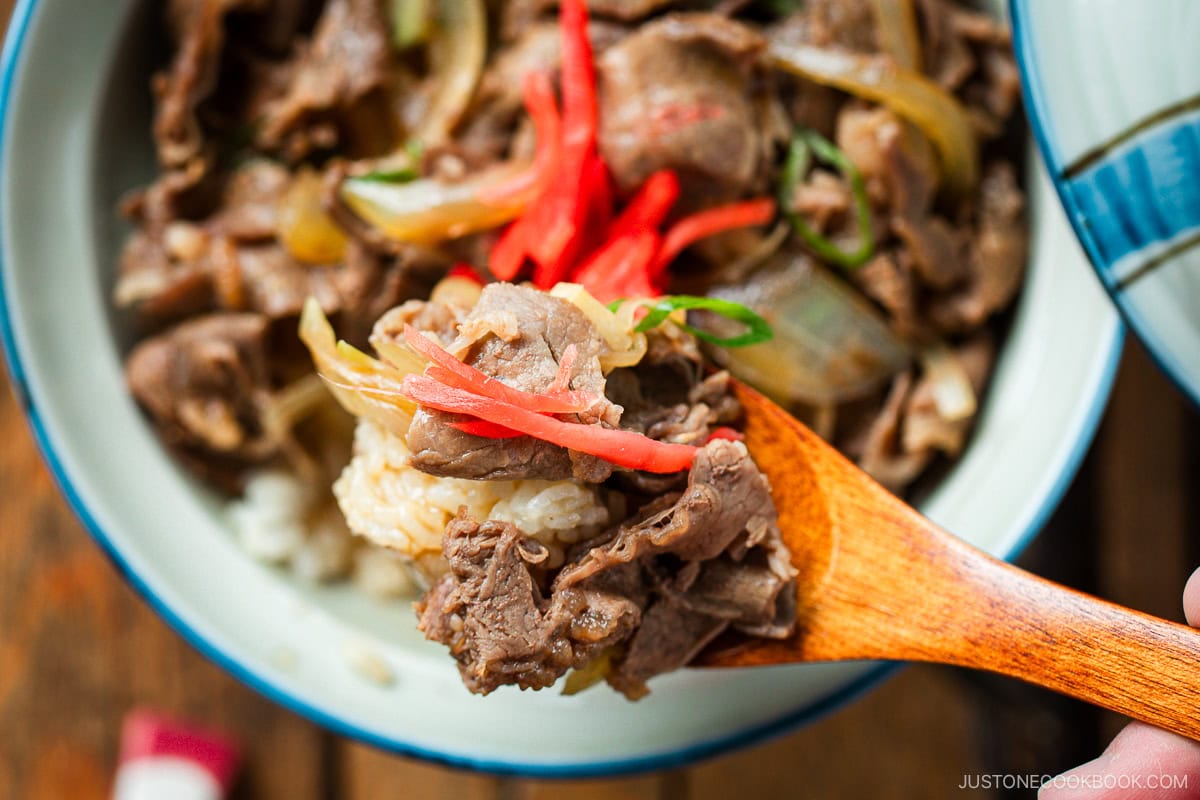
Table of Contents
Why I Love This Recipe
- Ready in just 20 minutes – This gyudon recipe is perfect for a weeknight meal and the kind that I love making when I don’t have a lot of time.
- Simple yet nourishing – Made using 3 fresh ingredients and a handful of pantry staples, you can put together a protein-rich, one-bowl meal. It’s the kind of comforting everyday Japanese food that I enjoy cooking and serving at home.
- Savory and satisfying – Thanks to layers of umami flavor from the Japanese soup stock, aromatic cooked onions, and paperthin marbled beef, this recipe hits the spot for my family!
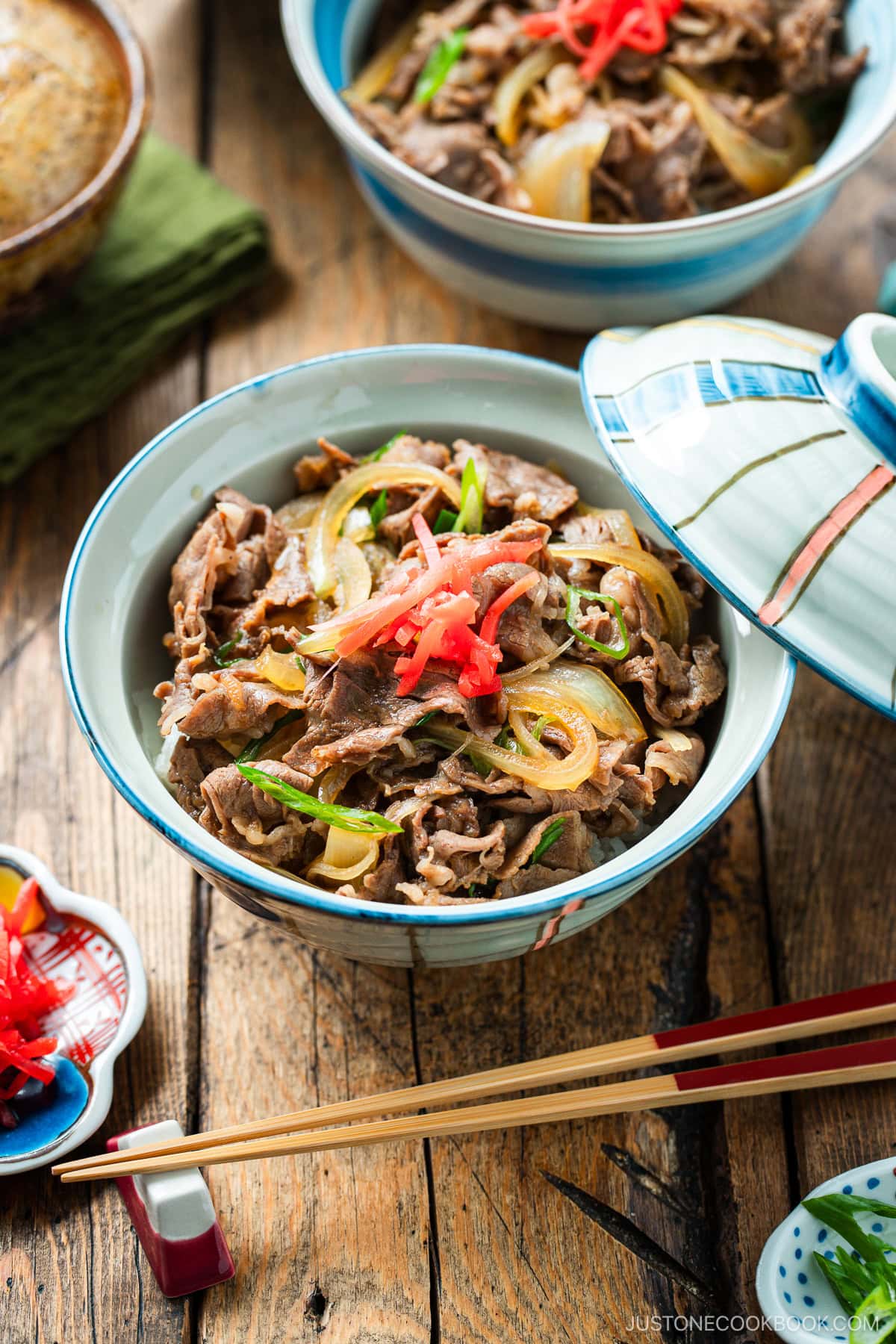
Ingredients for Gyudon
- Thinly sliced beef (chuck or ribeye)
- Onion
- Green onion/scallion
- Cooked Japanese short-grain rice
- Pickled red ginger (beni shoga or kizami beni shoga) – for garnish
- Sauce:
- Dashi (Japanese soup stock)
- Sake
- Mirin
- Soy sauce
- Sugar – to taste
Find the printable recipe with measurements below.
Jump to RecipeSubstitutions
- Thinly sliced beef: The paperthin sliced beef I use in the recipe is sold in Japanese and Asian groceries. If you can’t find it, you can also learn How To Slice Meat Thinly at home with my tutorial.
- Dashi: Japanese soup stock is essential for an authentic taste. I recommend making standard Awase Dashi from scratch or using a convenient dashi packet for the best result. You could also use dashi powder in a pinch.
- Sake: If you don’t have Japanese sake at home, try substituting dry sherry or Chinese rice wine. For a non-alcohol version, simply replace with water.
- Mirin: To skip the mirin, you can use 2 Tbsp sake/water + 2 tsp sugar for every 2 tablespoons of mirin.
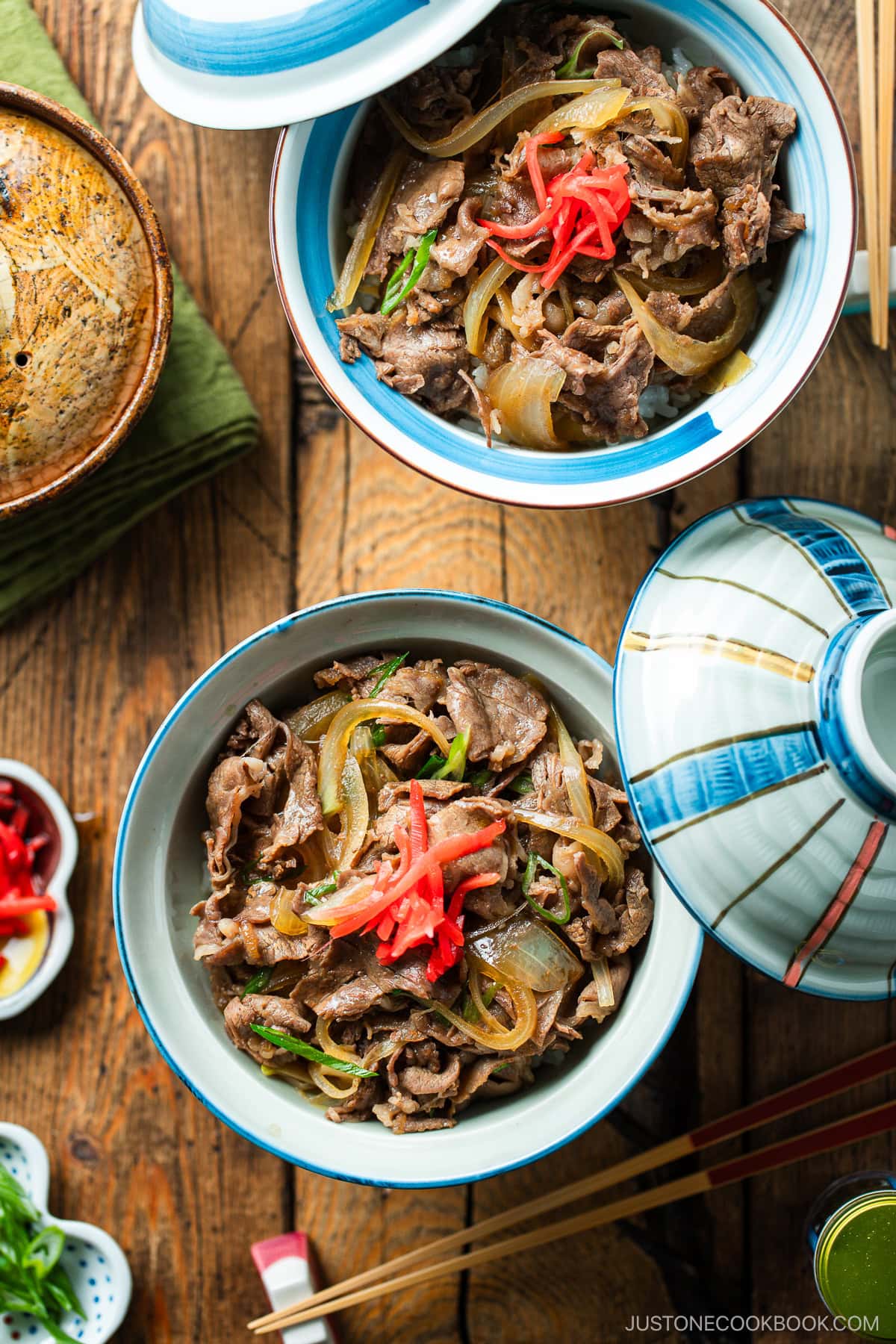
How to Make Gyudon
Preparation
Step 1 – Cut the onions and beef. Thinly slice the onion and green onion/scallion. Then, remove the thinly sliced beef from the freezer when it’s semi-frozen and slice the meat into pieces 3 inches (7.6 cm) wide.
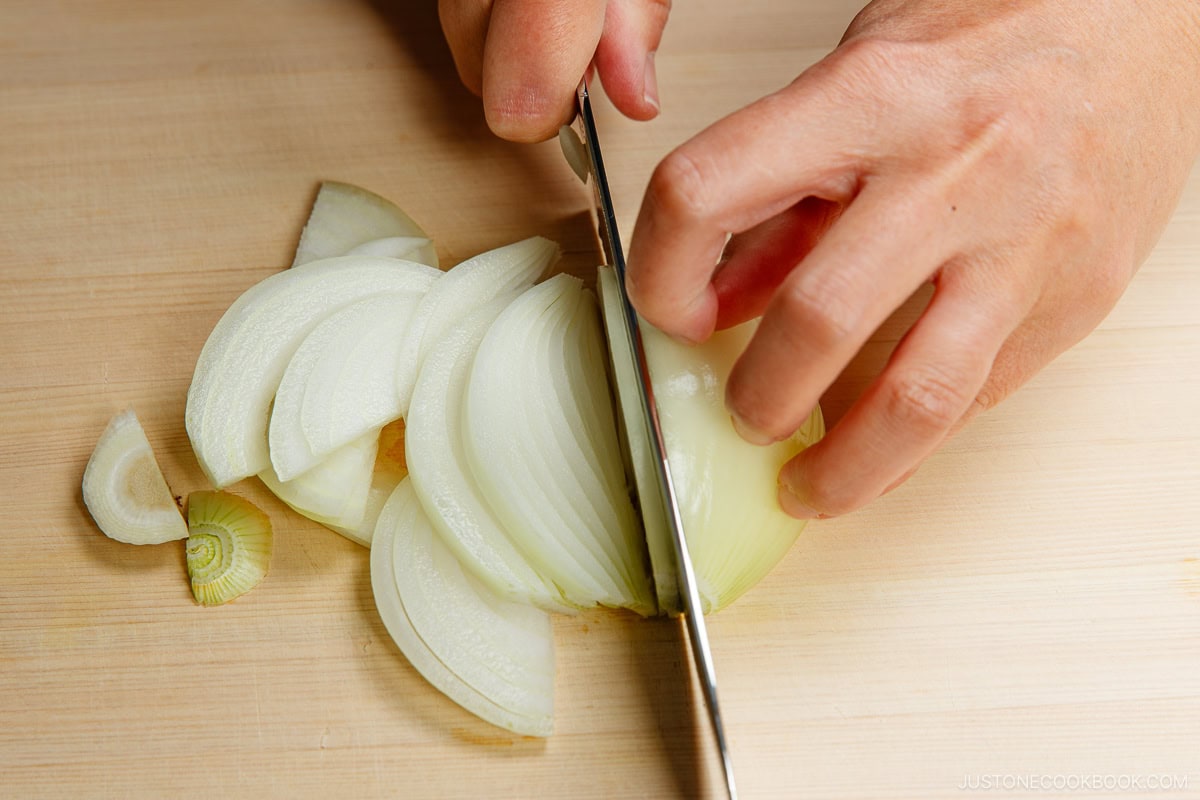
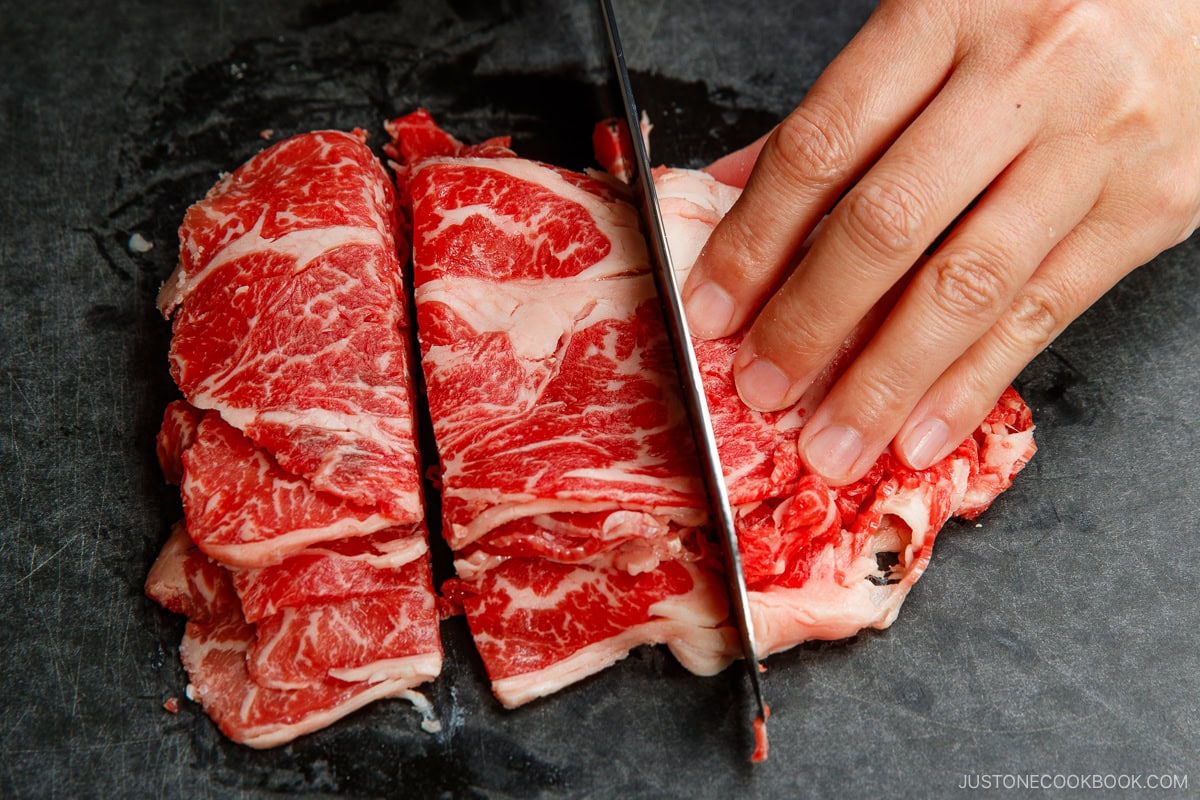
Step 2 – Add the seasonings to the cold pan. To a large frying pan (do not turn on the heat yet), add the dashi, sake, mirin, soy sauce, and sugar. Stir to combine.
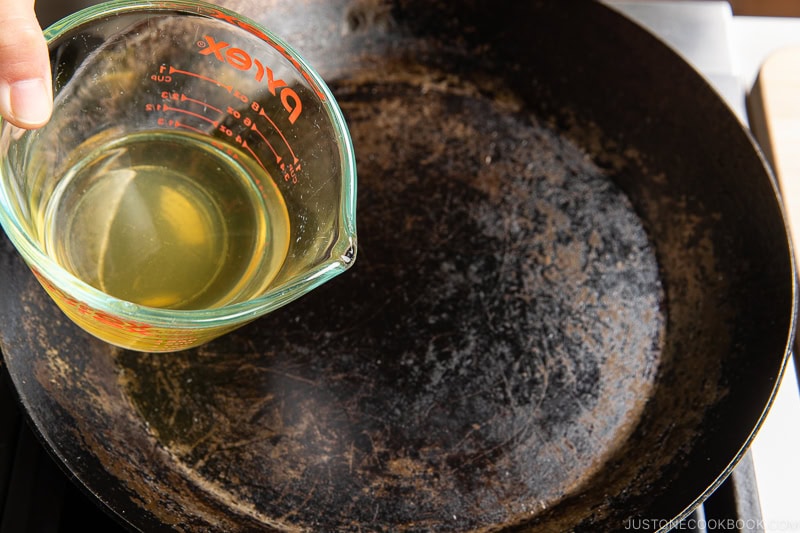
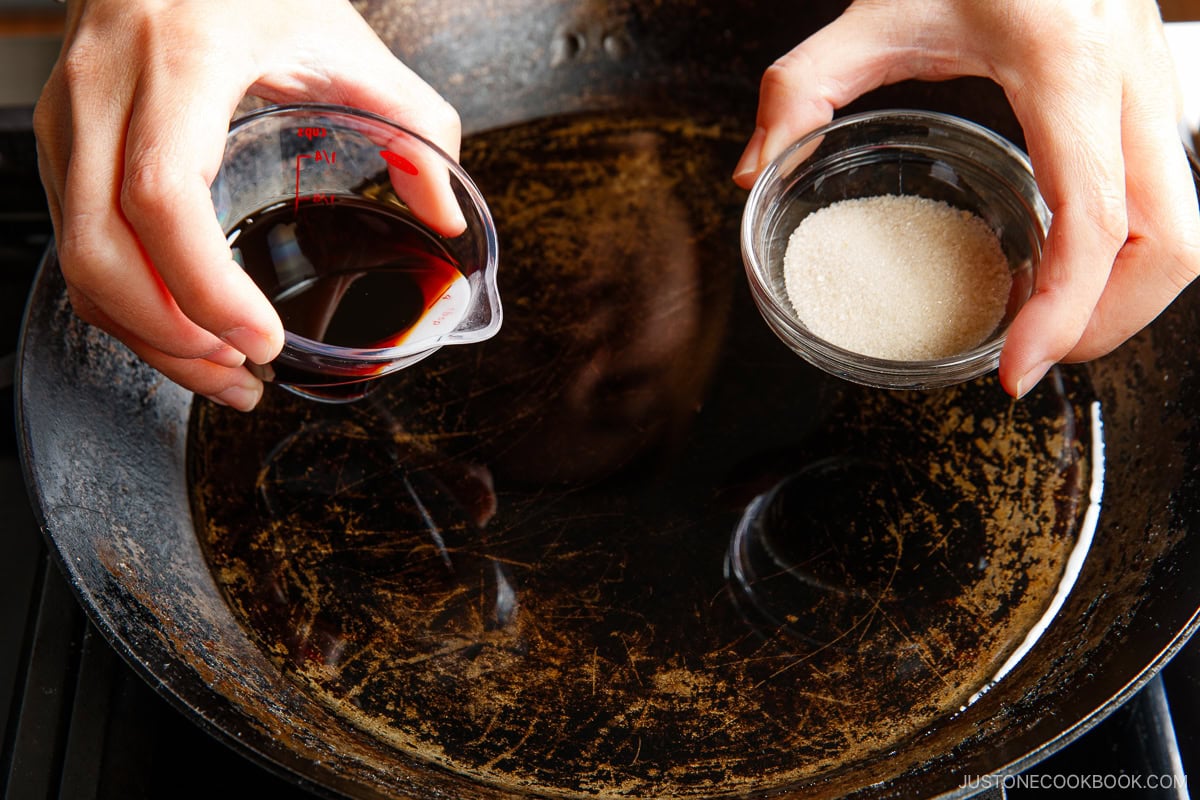
Step 3 – Layer the onions and meat in the pan. Scatter the onion slices into the sauce around the pan, separating the layers. Next, place the meat on top, separating the thin slices of beef so the meat covers the onions.

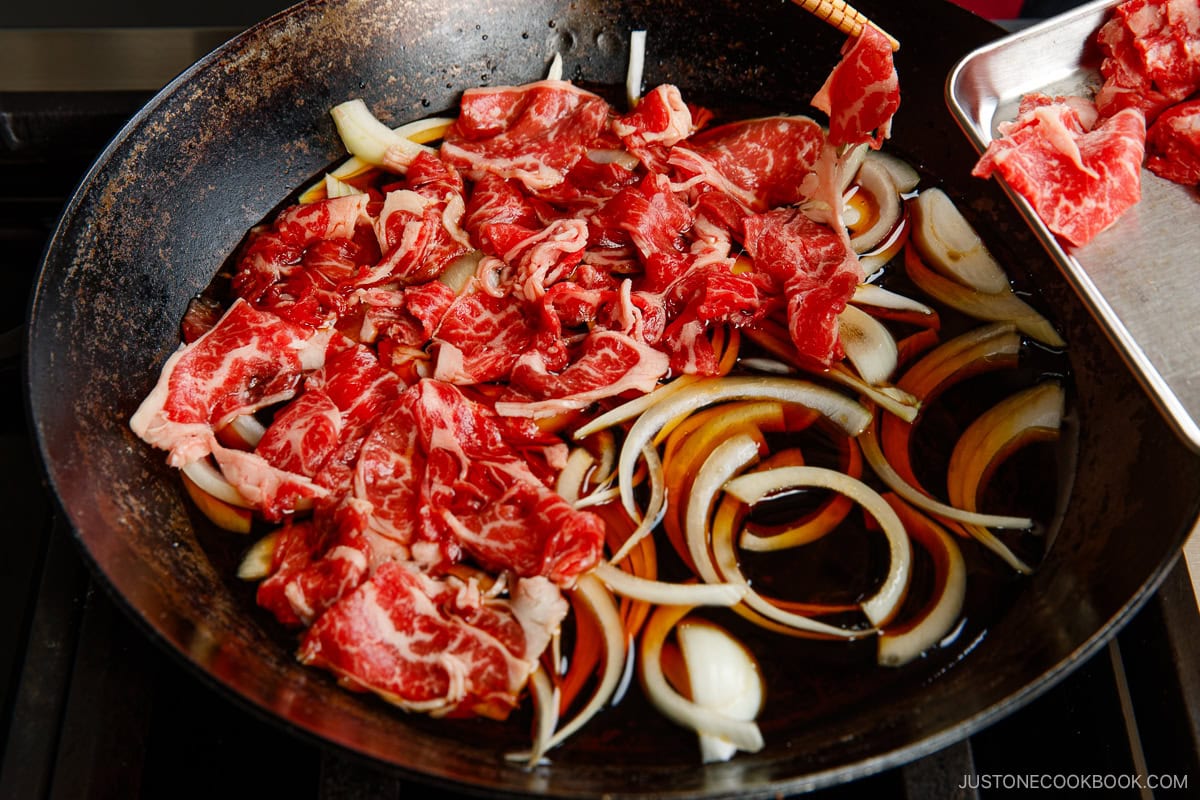
Cooking
Step 4 – Cover the pan with a lid and turn on the heat. Start cooking over medium heat. Once simmering, turn down the heat and cook, covered, for 3–4 minutes. Once in a while, open the lid and skim off the scum and fat from the broth with a fine-mesh skimmer.
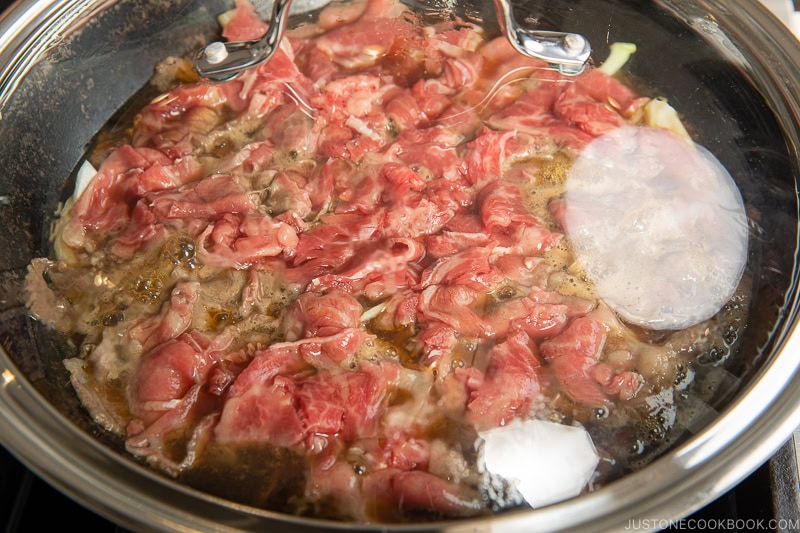
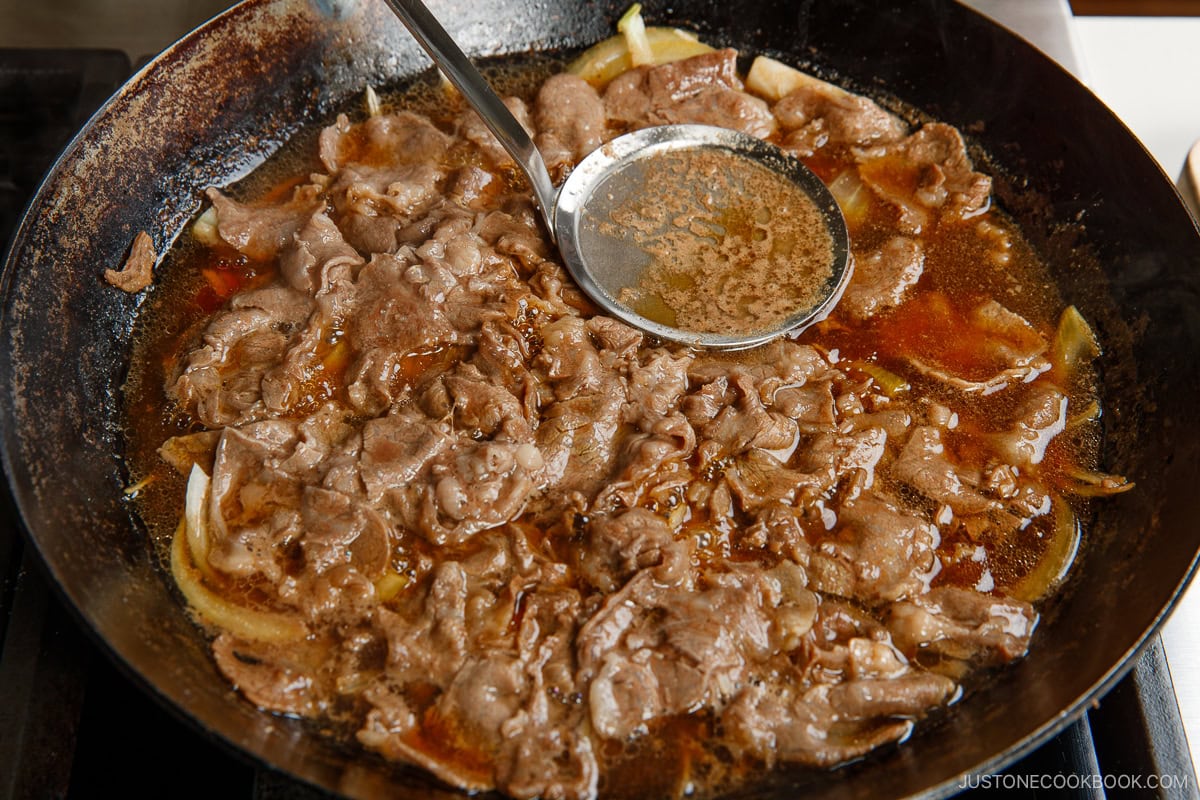
Assemble
Step 5 – Ladle over a bowl of hot steamed rice. Sprinkle the green onions on top and cook covered for another minute. Serve the steamed rice in large donburi bowls and spoon the beef and onions on top. Drizzle with some of the dashi broth in the pa
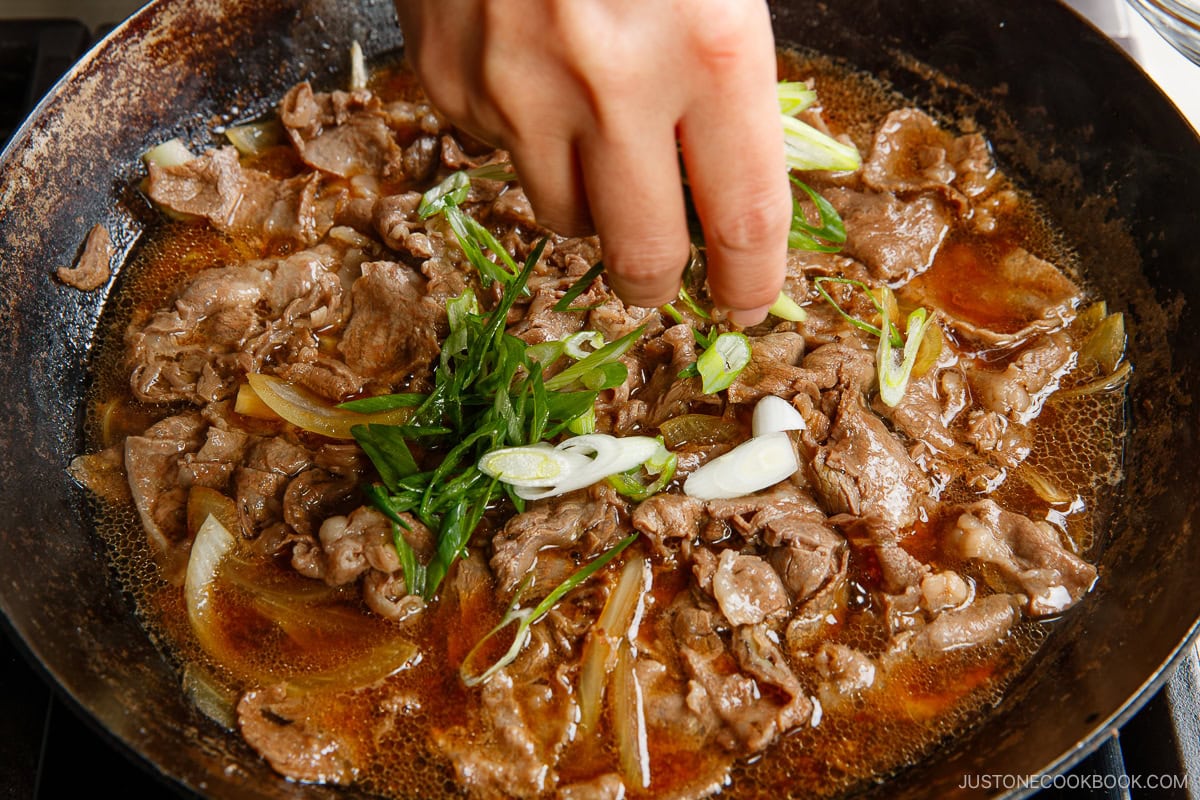
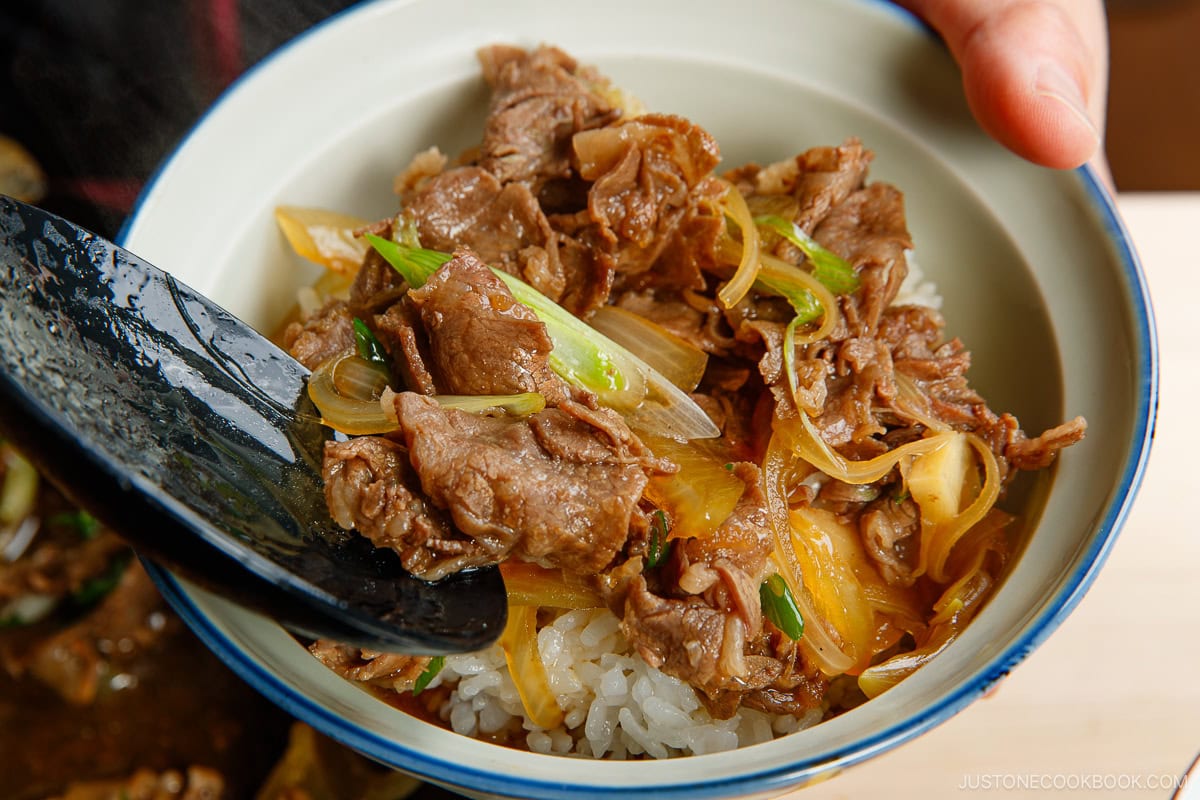
Step 6 – Enjoy! Top with red pickled ginger and serve immediately.
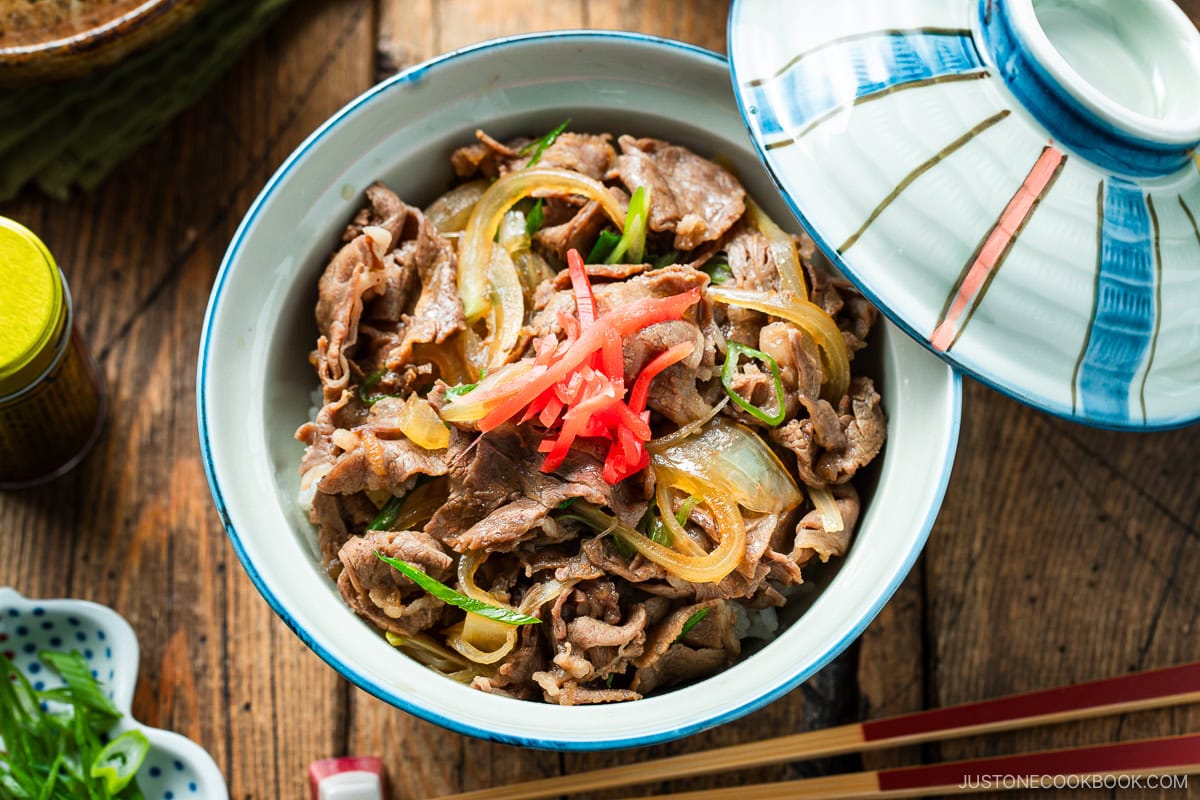
Nami’s Recipe Tips
- Thinly slice the onion so it becomes tender and sweeter quickly. I love the natural sweetness that the cooked onions impart to the dish.
- Use good-quality beef. Well-marbled beef will not become chewy after simmering in the sauce. Therefore, I highly recommend ribeye for gyudon. If you can’t find pre-sliced beef, read my tutorial (How To Slice Meat Thinly) to learn how to do it at home.
- Make extra dashi (Japanese soup stock) so you can use it for both the gyudon and some miso soup to go with the meal. For the best result, I recommend making dashi either from scratch or with a dashi packet.
- Cook more rice than usual. Rice bowl dishes called donburi typically serve more rice per serving, typically 1⅔ cups (250 g), to go with the food on top. Therefore, please prepare a little bit more than usual. I always make 1½ rice cooker cups for two servings and 3 rice cooker cups for four servings.
- Don’t overcook the beef, especially if your meat is not well-marbled. You don’t want chewy meat. I always stop cooking as soon as the beef is no longer pink. If the meat is well-marbled, you can let it simmer slightly longer to allow the meat to absorb more flavors from the sauce.
Variations and Customizations
Gyudon is a simple dish that you can easily enhance with other ingredients. Here are a few of my suggestions.
- Serve it with an egg. In Japan, it’s popular to serve gyudon with different types of eggs to add richness and protein. When we place a raw egg yolk in the center of the simmered beef, we call it tsukimi gyudon (お月見牛丼). I love adding a poached egg on top for gyudon with Onsen Tamago (温玉のせ牛丼). Finally, in Tanindon (他人丼) or gyutojidon (牛とじ丼), we drizzle beaten eggs over the simmered beef and cook covered until eggs are still runny but just set, similar to oyakodon.
- Make it sukiyaki style. Known as Kansai-style gyudon, this variation is cooked in the manner of that region’s sukiyaki where the sugar is sprinkled on the thin-sliced raw beef before it’s cooked and simmered with the other seasonings. Interestingly, Kansai-style gyudon does not always require dashi; therefore, the flavor is more intense. I grew up eating gyudon at home this way, as my grandmother and mother were raised in the Kansai cities of Nara and Osaka, respectively. You can find the cooking steps for my original 2011 beef bowl recipe Kansai Sukiyaki-style Gyudon in the Notes section of the recipe card below.
- Make it with chicken. If you want to change up the protein, I recommend making it with chicken and drizzling beaten egg into the pan toward the end of cooking. Now, you’ve made Oyakodon! See my recipe on the blog for complete instructions.
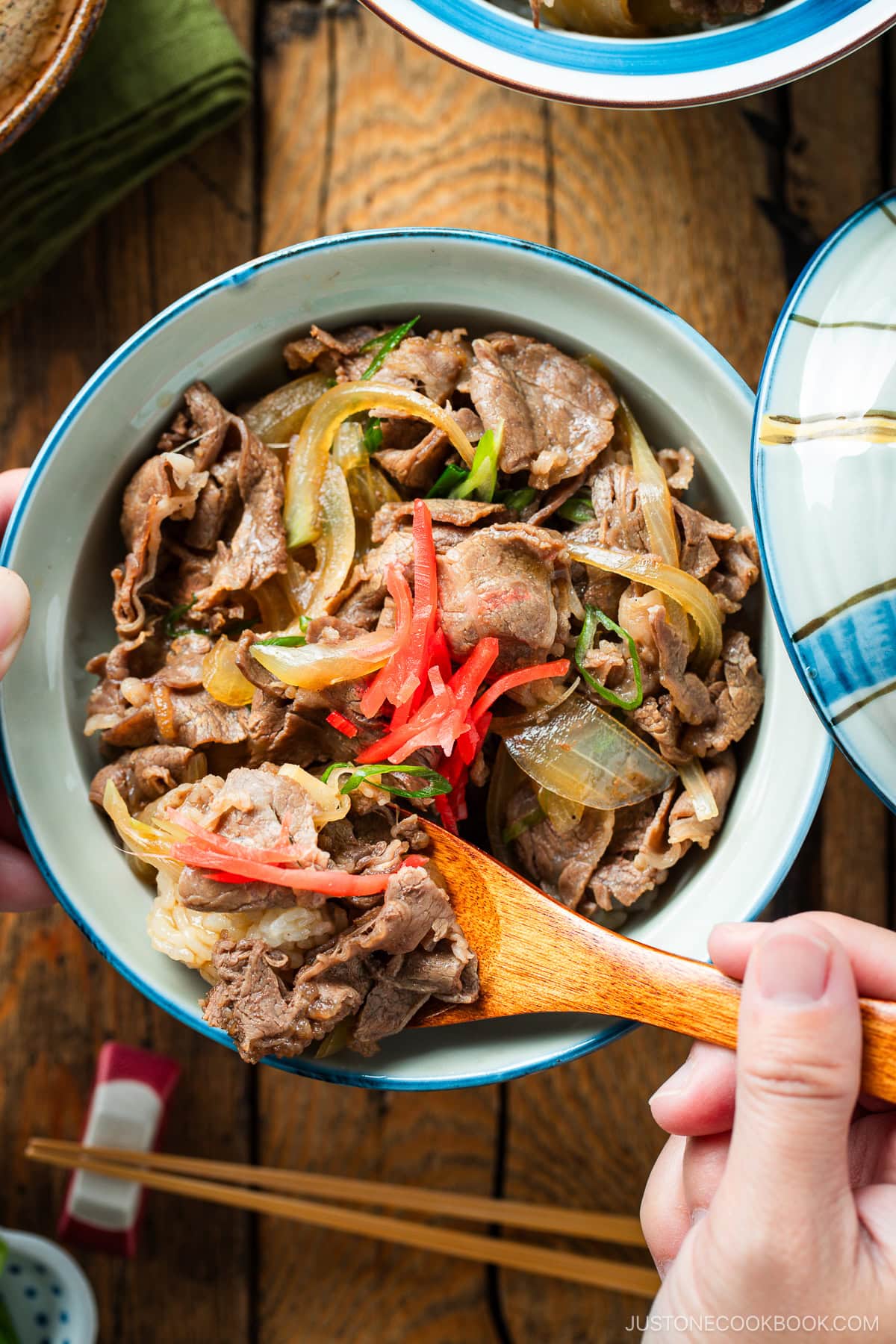
What to Serve with Gyudon
Gyudon is a hearty one-bowl meal that you can serve on its own. To add variety and extra nourishment, I suggest pairing it with these following dishes.
- With soup – Add seasonal produce to your meal with my versatile Vegetable Miso Soup.
- With a side dish – Kinpira Gobo is a great make-ahead side dish to round out the meal.
- With a salad – Broccolini Gomaae is a vegetable recipe that goes well with everything.
- With pickles – I love to serve refreshing Japanese Pickled Cabbage to contrast with the richness of the beef.
Storage and Reheating Tips
To store: You can keep any leftover beef and onion mixture in an airtight container and store in the refrigerator for up to 2–3 days. You can also store it in the freezer for up to 3–4 weeks.
To reheat: Heat gently in a saucepan with the simmering liquid until warm.
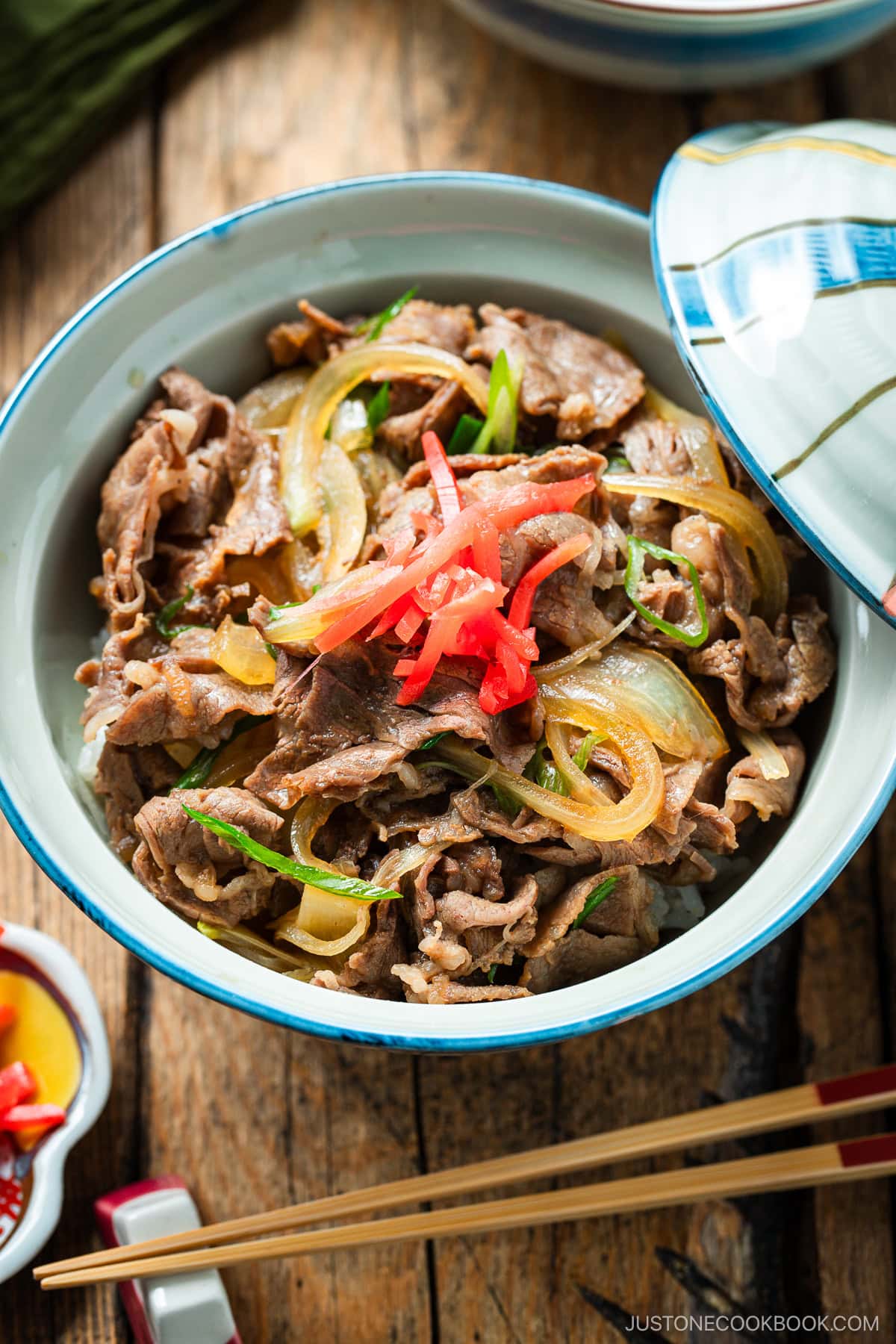
Frequently Asked Questions
You may have used meat that is not well-marbled. To avoid chewy beef, please stop cooking as soon as the beef is no longer pink. Also, please use paperthin slices of well-marbled beef. If the meat is well-marbled, you can let it simmer slightly longer to allow the meat to absorb more flavors from the sauce.
More Beef Bowl Recipes
If you love this Gyudon, you’re in for a treat with these other irresistible Japanese beef bowl recipes.
- Tanindon (Beef and Egg Rice Bowl)
- Sukiyaki Don

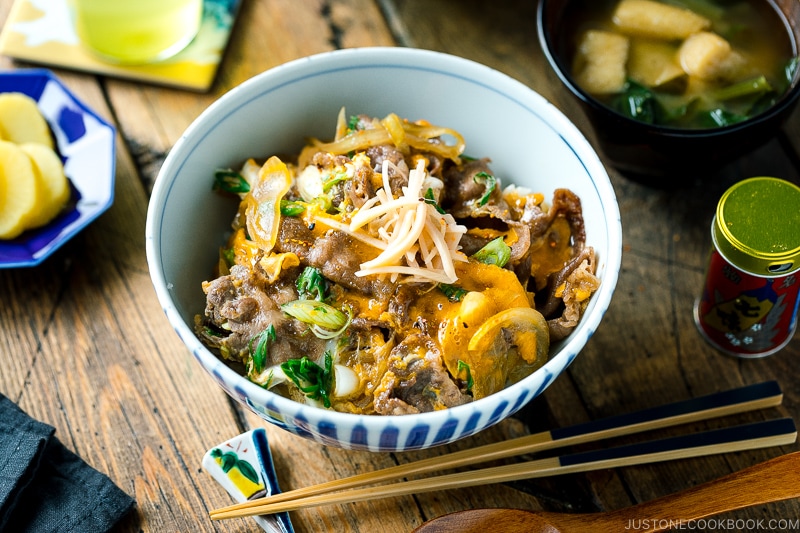
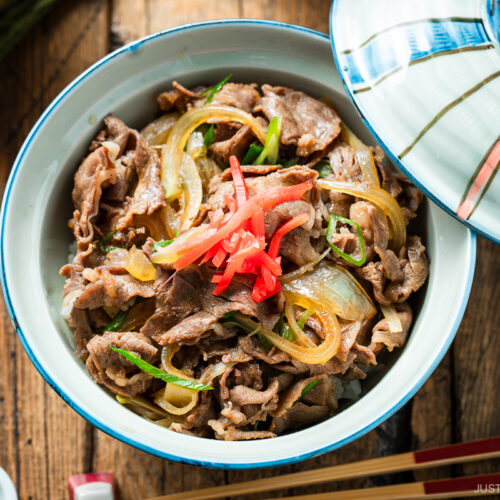
Gyudon (Japanese Beef Rice Bowl)
Video
Ingredients
- ½ onion (4 oz, 113 g)
- 1 green onion/scallion
- ½ lb thinly sliced beef (such as ribeye) (you can also slice your own meat)
For the Sauce
- ½ cup dashi (Japanese soup stock) (use standard Awase Dashi, dashi packet or powder, or Vegan Dashi)
- 2 Tbsp sake (substitute with dry sherry or Chinese rice wine, or use water for a non-alcohol version)
- 2 Tbsp mirin (or use 2 Tbsp sake/water + 2 tsp sugar)
- 3 Tbsp soy sauce
- 1 Tbsp sugar (to taste)
For Serving
- 2 servings cooked Japanese short-grain rice (typically 1⅔ cups (250 g) per donburi serving)
- pickled red ginger (beni shoga or kizami beni shoga) (to garnish)
Instructions
Before You Start…
- For the steamed rice, please note that 1½ cups (2 rice cooker cups, 300 g) of uncooked Japanese short-grain rice yield 4⅓ cups (660 g) of cooked rice, enough for 2 donburi servings (3⅓ cups, 500 g). See how to cook short-grain rice with a rice cooker, pot over the stove, Instant Pot, or donabe.
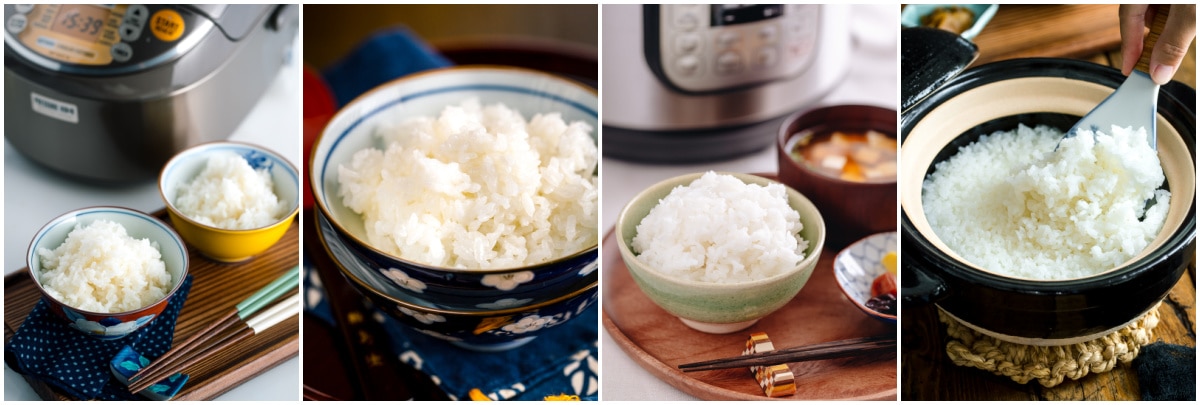
- Gather all the ingredients. I usually put the thinly sliced beef in the freezer for 10 minutes because it‘s a lot easier to cut semi-frozen meat.
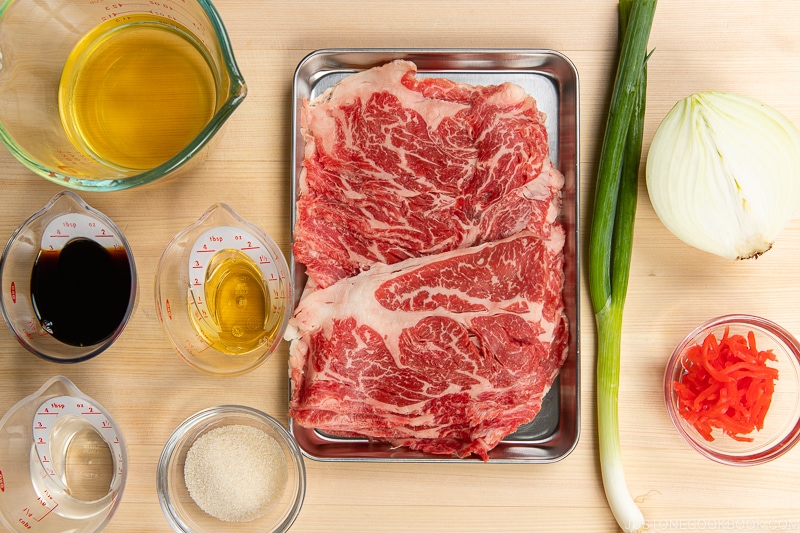
To Prepare the Ingredients
- First, thinly slice ½ onion.
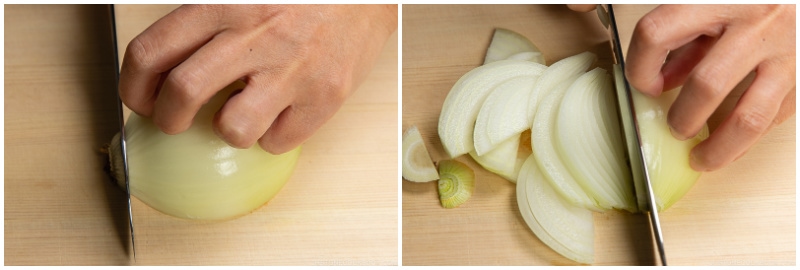
- Next, cut 1 green onion/scallion diagonally into thin slices. Set aside.
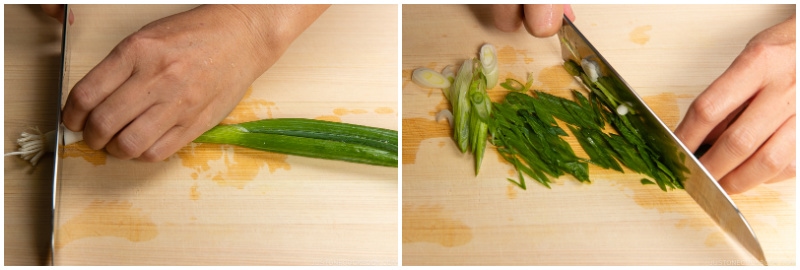
- Then, remove ½ lb thinly sliced beef (such as ribeye) from the freezer. Cut the semi-frozen meat into pieces 3 inches (7.6 cm) wide.
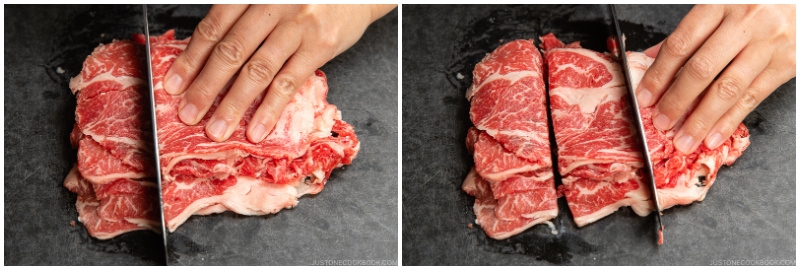
- In a large frying pan (do not turn on the heat yet), add ½ cup dashi (Japanese soup stock), 2 Tbsp sake, 2 Tbsp mirin, 3 Tbsp soy sauce, and 1 Tbsp sugar. Stir to combine and dissolve the sugar.
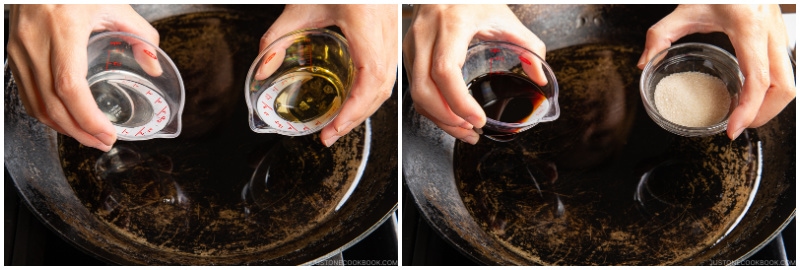
- Next, add the onion slices and spread them in the broth throughout the pan, separating the onion layers.
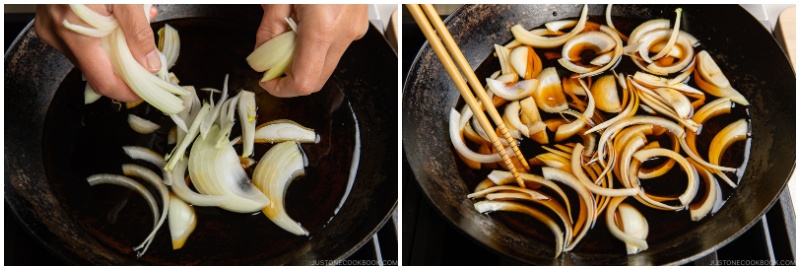
- Then, distribute the meat on top of the onions. Separate the thin slices of beef so the meat covers the onions.
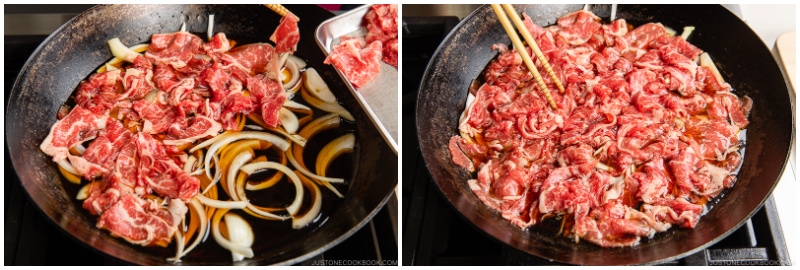
To Cook
- Cover the pan with a lid. Now, turn on the heat to medium and start cooking. Once simmering, turn down the heat to simmer and cook, covered, for 3–4 minutes.
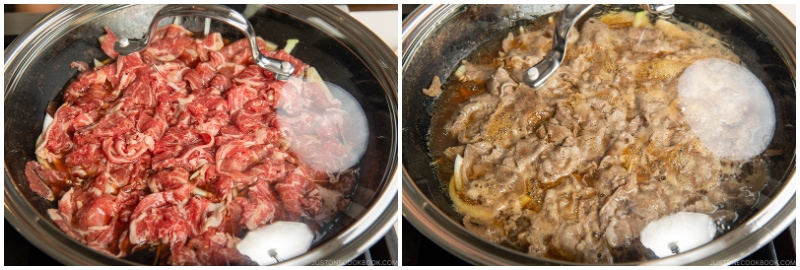
- While simmering, open the lid and skim off the scum and fat from the broth once or twice with a fine-mesh skimmer (find it on Amazon and JOC Goods).
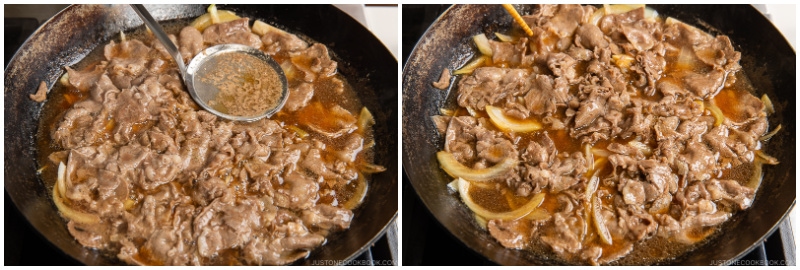
- Sprinkle the green onions on top and cook covered for another minute. Optional: If you would like to add beaten eggs, you can do it now (refer to my Tanindon recipe for detailed instructions).
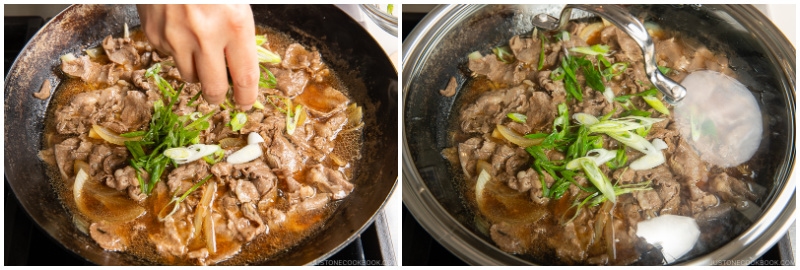
To Serve
- Divide 2 servings cooked Japanese short-grain rice into large donburi bowls. Then, drizzle some of the pan sauce on top of the rice.
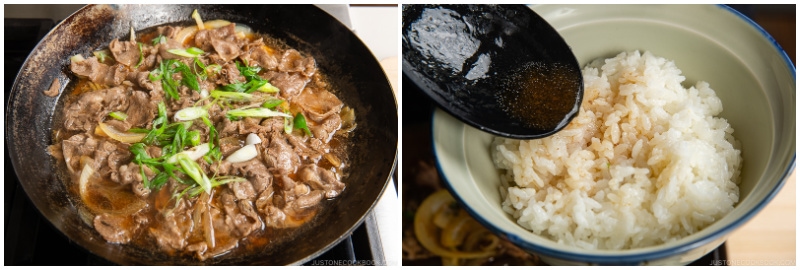
- Put the beef and onion mixture on top of the rice. If you’d like, drizzle additional remaining sauce on top. Top the gyudon with pickled red ginger (beni shoga or kizami beni shoga). Enjoy!
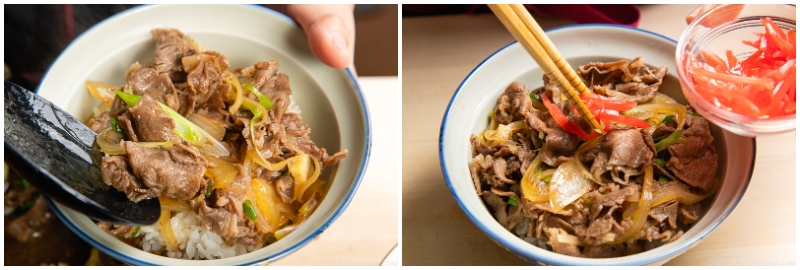
To Store
- You can keep any leftover beef and egg mixture in an airtight container and store in the refrigerator for up to 2–3 days and in the freezer for up to 3–4 weeks.
Notes
Equipment
- rice cooker (or use a pot, donabe, or Instant Pot)
Nutrition
Editor’s Note: The post was originally published on January 13, 2011. The recipe was revised on April 17, 2022. The post was republished with a new video on April 5, 2024, and with more helpful content on December 15, 2024.
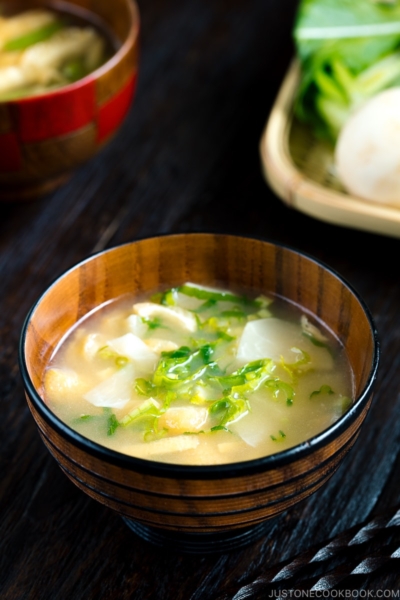
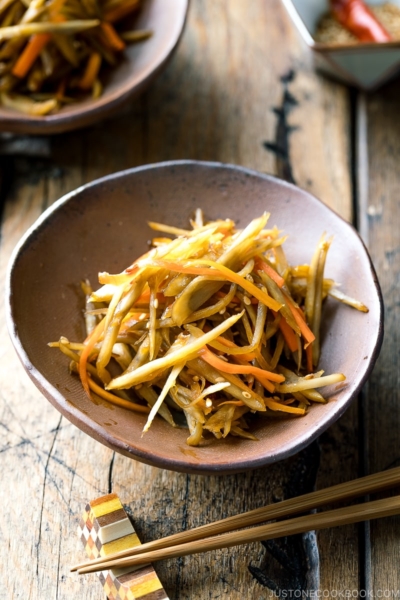
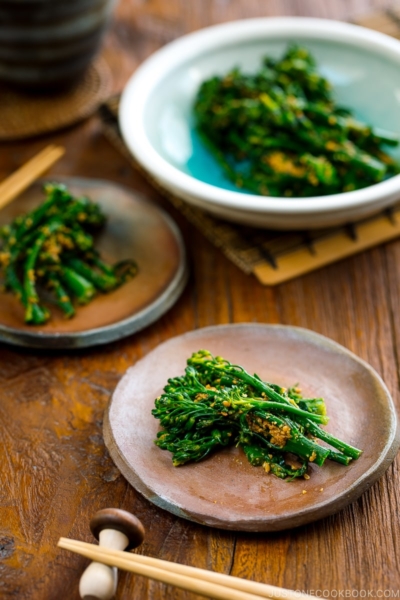
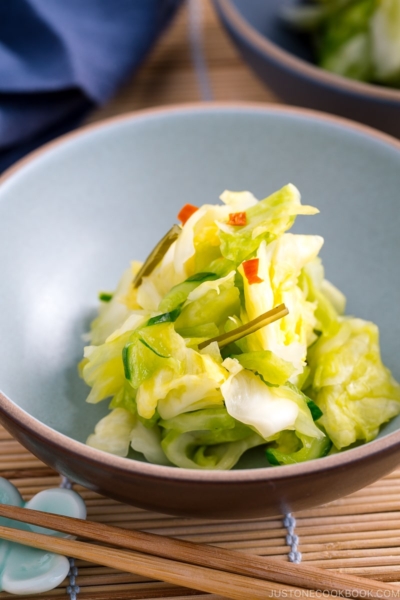




I love this recipe so much and it’s my go-to when I crave a comforting bowl of deliciousness. Thank you so much! However, I found that the original recipe was more to my taste – this revised one is delicious, too, but is the original recipe available anywhere or could it be added to this, please? 😊
Agreed I would also love to know about the original recipe 🙂
Please read my answer to Natalia. 🙂
Hi Natalia! I’m so glad you like the original recipe from 11 years ago. That’s how my mom cooks gyudon, which is Kansai-style and with the egg.
Back then, SEO wasn’t that important for blogging, and I didn’t have to worry about keywords and I could share whatever I like to write… However, blogging has become way more technical and now I have to think and write with SEO stuff in mind.
To get to my point, the original recipe (from 2011) should be named differently—either Kansai Sukiyaki-style Gyutoji or Kansai Sukiyaki-Style Tanindon. When people are looking for “gyudon,” there are specific things/answers that they look for. Unfortunately, not my “mom’s gyudon.”
As I was aware that many readers enjoy the original recipe, I already mentioned in the post how you use my current recipe to make the original recipe.
The good part is that the NEW RECIPE IS THE SAME as the old one, except for the addition of dashi in the ingredient list.
So, if you want to make the old recipe, just SKIP dashi in the recipe. You also need a tablespoon of oil to stir fry onion and beef but the measurement for condiments are all the same.
Please read the instructions written under Kansai-style Gyudon (right under my old image of gyudon that you’re familiar). Why it’s not on the recipe card? It’s VERY confusing to write two different steps, so I can’t do that…
I hope this helps!
Hi – this is the easy easy recipe and it is delicious. It is one of my sons favorites. We used to buy frozen gyudon at an asian specialty store until I got brave and made this. I have been told never to buy it again . Your recipe was absolutely delicious. Thank you again.
Hello Nancy! Thank you so much for taking your time to write feedback. I’m so happy your family enjoyed this recipe and can make it from scratch now (a lot healthier!). Thank you for your kind words! 🙂
Hi Nami,
I’m wondering if its possible to cut back on the sugar, say to half or 1 tsp.? I’m not fond of sweet dishes.
Hi Vanessa! Sure! It’s up to you and you can adjust the sweetness according to your liking. Hope you enjoy this dish! 🙂
I was wondering what i should use as a sub for Sake? No where here has any to buy, would it be okay to just leave it out of the recipe?
Hi Haylie! You can omit sake, and it will be still okay! Hope you enjoy this recipe. 🙂
Just wanted to let you know that I made this tonight. It was excellent! I know we’ll be making it again many, many times. Thanks for sharing.
MJ, so happy to hear you tried this recipe! I’m very happy to hear you enjoyed it. 🙂 It’s one of our go-to Donburi (rice bowl) Recipes. Thank you for your feedback!
Made this tonight. Tasted great! Though, how dry is it supposed to be? Maybe I cooked out too much liquid…
Anyway, the kizami Shoga was a nice touch! Also, Korean kimchi goes really well with this too 🙂
Hi Steven! Hmm it’s up to you. If you prefer to have more sauce, you can keep some at Step 5. I like to keep it a little bit but I don’t want to make rice too soupy. Hope that helps. Oh yes, Kizami Shoga is a great accent. I should try Kimchi next time! 🙂 Thank you so much for trying this recipe!
I just made this recipe tonight for dinner, it was yummy! I had never tried putting eggs in it before, that was a good addition and what I had been missing in the past. My husband and I lived in Japan for 2 years and this really took us back.
I didn’t have any sake, so I used red wine instead. I also used deli roast beef to make my life easier, as we have no Japanese market nearby and I didn’t have time to freeze then slice a roast. It worked out really well. My 18 month old son loved it as much as we did!
Hi Dana! You must have tried many Japanese dishes while you stayed in Japan for 2 years. 🙂 I’m glad you and your husband enjoyed Gyudon. My children enjoyed this dish too when they were that age – I chopped up meat into small pieces. Thanks for leaving your feedback here! 🙂
My supermarket will thin slice any cut I ask for. I made this using a nice sirloin tip roast that was on sale and asked the meat department to slice it thin. Works wonderfully for this as well as for making teriyaki beef rolls.
Thank you for sharing your tip with us!
Is this okay to store/cool and then reheat? @____@
Yes I eat the leftover next day or put in my son’s lunch box too. 🙂
Hi nami
Can we use shabu shabu meat For this dish?
Hi Margaret, Sure, you can. Thank you for trying this recipe!
I tried to oyakodon but following this recipe. I failed as some of the egg burnt hahaha! Nevertheless I loved the taste!
Hi Jillian! Thank you so much for trying my recipe! Oyakodon is slightly different cooking method compared to Gyudon. I’ll share the link for Oyakodon recipe here: https://www.justonecookbook.com/recipes/oyakodon/
Thank you so much for your feedback!
Hai Nami.. i made this recipe yesterday for dinner, with some modification because i don’t consume sake and mirin. It is quick, easy but very delicious.. love it!! thanks for sharing this recipe with us 🙂
i also post my gyudon based on your recipe on my blog, but it is in Indonesian language.. 🙂
Hi Ika! Thanks for trying this recipe! I’m going to check it out now. 🙂
Thanks! One of my favrites
Yum! I love one dish meals too, so easy to cook and uses less utensils! Cooking at home is always so much cheaper, I had ramen in a Japanese Restaurant last weekend and the bill equals to a week’s groceries! But to their credit, the ramen was good!
Gyudon is one of my favorites! I didn’t know it was this easy to make. Thanks so much!
I love all your recipes & tips! You make Japanese cooking easy, accessible and fun. I’ve learned so much and look forward to your emails every week. Doomo doomo!!
Hi Eric, Thank you very much for your kind feedback! We are so happy to hear you enjoy Japanese cooking. Thank you for subscribing to Nami’s newsletter.🙂
Love eating this at restaurants! But they`re like $7 a bowl! Ahaha. I will totally make this soon!
So..I made these the other day…and I LOVED IT! So good & simple ♥ I need to try making this dish again!
Thank you Lynna! I cook this often, but I don’t get to photograph again because I usually cook when I’m busy. I’m going to photo shoot this again this weekend! =) Really happy to hear you liked it! 🙂
Hi Nami!
I just made this dish and it turns out so good! I am so proud of myself and of course thanks to your step by step directions! I am wondering if I can feed this to my kids because I used sake.
Thanks so much 🙂
Hi San-San!
I’m really happy to hear you liked this dish. 🙂 Alcohol is evaporated while cooking, so you don’t have to worry about alcohol content. Depends on child’s age, raw eggs/half cooked egg should be careful. You want to make sure eggs are fully cooked for the kids. You can chop meat/onion into small pieces or you can grind them if your child is too small to eat bigger chunks. I used to use a Japanese grinder and wooden pestle (for grinding sesame seeds) to smush the food.
Hi Naomi! I’ve cooked this recipe for my parents and they loved it! Thank you so much for this lovely recipe!
Hi Greta! Thank you for your kind feedback! I’m so happy to hear you and your parents enjoyed it!
Hi Nami!
I just made this dish and it was a hit! It is really delicious! Thank you for this awesome recipe…
Hi Ozlem! Yay! Nami and JOC team are so happy to hear it turned out delicious, and you enjoyed it!
Thank you very much for your kind feedback!
Nami, I’ve cooked this recipe last weekend.. so easy and yummy. just like served in the restaurant, but much cheaper! I used minced beef instead of sliced beef, will it still called Gyudon? want to post this recipe on my blog
Hi Shannon! Usually we use slice beef for gyudon and when we use minced meat we call it “Soboro Don” (if it’s beef, Gyu Soboro Don). Soboro means cooked minced meat. But if you followed gyudon’s recipe, I think you can just say you use minced instead of sliced and call it gyudon? Soboro Don usually have scrambled egg instead of more runny egg like Gyudon. I can’t wait to see it on your blog!